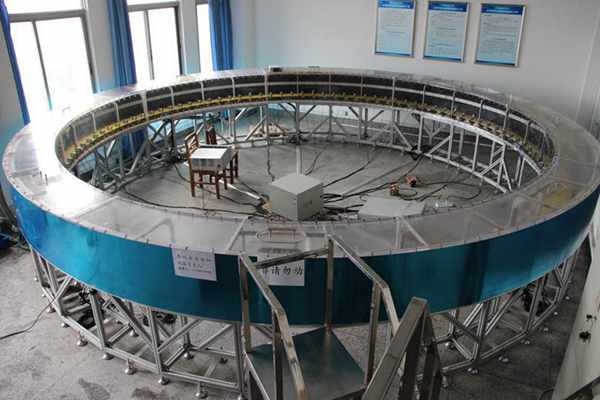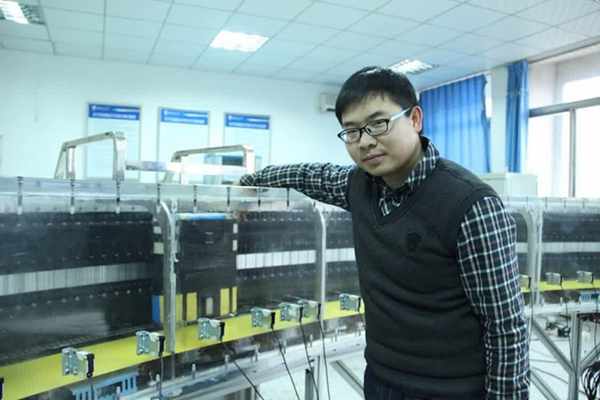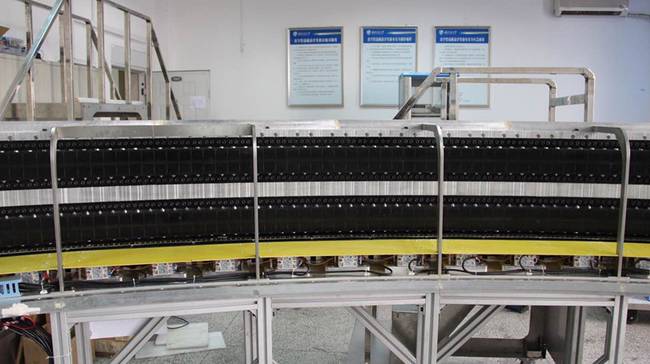


A test line for the ultra-high-speed vacuum maglev train will be built in China in 2017, experts revealed at a rail transportation conference on Nov. 27.
At the conference, professor Zhang Weihua of Southwest Jiaotong University showcased the latest technologies in high-speed rail transportation, including evacuated-tube high-temperature superconducting maglev trains. High-speed maglev trains boasting speeds of up to 600 kilometers per hour are being developed in China, attendees learned.
“The first medium-low speed maglev line, independently developed by China, is now operating smoothly in Changsha. This is a good model for the promotion of maglev technology. Currently, we are actively developing high-speed maglev trains,“ said Qian Qingquan, an academician with China’s Academy of Engineering.

The second generation evacuated tube developed by the team.
According to previous report by Chengdu Business News, Southwest Jiaotong University has completed a test of the evacuated-tube HTS maglev system, which was developed by Professor Zhao Yong and his team.
“We think the speed of maglev trains will reach 600 to 1,000 kilometers per hour, fast enough to replace airplanes,” Zhao said.
The team successfully lowered pressure in the tube to 1,335 pa – or just 1 percent of air remaining in the tube. They also increased the average speed of the maglev train to 82.5 kilometers per hour under normal pressure.
As of May, work on the system was progressing well.

“The speed has been increased to 100 kilometers per hour under normal pressure,” Zhao explained. With improvements of the vacuum technology, speeds will continue to increase dramatically.
Zhao and his team developed the world's first evacuated-tube HTS maglev test line in 2011. The tube is 3 meters in diameter with a lowest pressure of 2,000 pa. In his second-generation system, tracks were "hung" on the wall of the tube, which increases centripetal force on the running train, as well as speed and stability.

Tracks are "hung" on the wall of the tube.
However, Shen Zhiyun, an academician with the Chinese Academy of Engineering, expressed concern about the high costs associated with building vacuum trains.
“There is no big problem technically, but the cost is too high. One kilometer of subway costs 800 million RMB, and even 1 billion is not enough to build 1 kilometer of evacuated-tube HTS maglev tracks,” he said.
 Fire brigade in Shanghai holds group wedding
Fire brigade in Shanghai holds group wedding Tourists enjoy ice sculptures in Datan Town, north China
Tourists enjoy ice sculptures in Datan Town, north China Sunset scenery of Dayan Pagoda in Xi'an
Sunset scenery of Dayan Pagoda in Xi'an Tourists have fun at scenic spot in Nanlong Town, NW China
Tourists have fun at scenic spot in Nanlong Town, NW China Harbin attracts tourists by making best use of ice in winter
Harbin attracts tourists by making best use of ice in winter In pics: FIS Alpine Ski Women's World Cup Slalom
In pics: FIS Alpine Ski Women's World Cup Slalom Black-necked cranes rest at reservoir in Lhunzhub County, Lhasa
Black-necked cranes rest at reservoir in Lhunzhub County, Lhasa China's FAST telescope will be available to foreign scientists in April
China's FAST telescope will be available to foreign scientists in April "She power" plays indispensable role in poverty alleviation
"She power" plays indispensable role in poverty alleviation Top 10 world news events of People's Daily in 2020
Top 10 world news events of People's Daily in 2020 Top 10 China news events of People's Daily in 2020
Top 10 China news events of People's Daily in 2020 Top 10 media buzzwords of 2020
Top 10 media buzzwords of 2020 Year-ender:10 major tourism stories of 2020
Year-ender:10 major tourism stories of 2020 No interference in Venezuelan issues
No interference in Venezuelan issues
 Biz prepares for trade spat
Biz prepares for trade spat
 Broadcasting Continent
Broadcasting Continent Australia wins Chinese CEOs as US loses
Australia wins Chinese CEOs as US loses